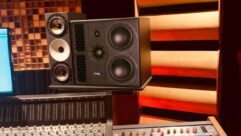
AV Revitalization of Texas Music Theater, Part 2
Jul 12, 2011 11:54 AM,
with Bennett Liles
Listen to the Podcasts
|
Editor’s note: For your convenience, this transcription of the podcast includes timestamps. If you are listening to the podcast and reading its accompanying transcription, you can use the timestamps to jump to any part of the audio podcast by simply dragging the slider on the podcast to the time indicated in the transcription.
When Gray Gregson and his friends took on a complete renovation of the Texas Music Theater in San Marcos, Texas, they really had their work cut for them. Detailed acoustical treatment, new floors, and a complete new sound and lighting system gave the place a new life and Gray is here with all the details next up on the SVC podcast.
Gray, thanks for being back with me for Part 2 talking about the Texas Music Theater and all of the renovation that’s been going and the things you’ve done to make it band-friendly. One thing we didn’t get into real detail on in Part 1 was all the Renkus-Heinz stuff that you’ve got in there. The main house, what was that, a PNX 102 LA array that you’ve got?
That’s correct. We have a left and right line array up on stage and we have 16 Renkus-Heinz PNX 102 LA non-powered two-way line arrays and then under the stage we have five Renkus-Heinz ZRS 18 2B non-powered dual subs and then back in the balcony we hav—Renkus-Heinz just came out with these—there’s four of these Renkus-Heinz CFX 101 LA. They’re a point-and-shoot line array. They’re rangemodular point source array module line array. At least I think that’s what they’re called. [Timestamp: 1:41]
OK, and I think that particular model is externally powered?
Well we’ve got…we’re everything…the speakers we have…all the speakers that we have are non-powered. We have all our big power racks up by the monitor console off to the stage. [Timestamp: 1:53]
So where are the, I think you said DRS 18 dual 18in. subwoofers, where have you got those?
Well here’s what happened with that, the stage used to be curved and I’d made the stage square out…there were five holes under the stage when we came there, so I looked at this, and just on a space basis I wanted to put them under the stage but I didn’t want to create any wash-back under the stage and have any vibrations on the stage, (and the stage is concrete) so what I did is when we made the stage straight across, I took those ports that were there and we built birch plywood boxes that fit in the ports that were all glued and sealed together and airtight and I had them on the edge of the cabinets—the cabinets just slide and we poured concrete over them all so they’re all covered in concrete those boxes are and we slid the cabinets in there, I put them in a D coupler for the floor and then took the outside edge of them and put this Neoprene stuff around them so no sound would flow back up in there, and then under the stage on the back side of them where the back of the birch plywood cabinets were, I put 3,000lbs. of sand bags bumped up against those cabinets so I have no sound coming backwards under the stage at all—it’s a forward motion. And then the stage is topped with a hardwood floor, with Appalachian red oak, and you get up there and it’s solid as a rock. [Timestamp: 3:16]
So with all the passive speakers you’ve got in there did you have any sort of cabling issues in getting the signal to all those things, say with architecture in building?
What I did is you can get under the stage—we have an entrance under the stage and there’s lights under there and it’s only…if you’ve got to crawl under it, it’s probably about 3.5ft. from the…underneath there and on each side of the stage I drilled about a 6in. hole on the left and right part of the stage and our cabling under the stage goes down through there and then we put a small hole on the top of the cabinet and ran the wire through there and then we put the ends on the other end so it really wasn’t that big of a deal. We have snakes that run from our main mic pres where you plug in the mics on one side of the stage that run all under the stage clear to the other side so you have snakes that can be laid out anywhere on the stage you want. [Timestamp 4:02]
With as many different acts as you’ve got in there I would think that you’ve got to keep it flexible in being able to reconfigure things.
Well, we have two snakes; one’s a 32 channel, one’s a 24. We have a opening in the headliner snake and a opening act snake and then we have snakes for all the microphones up front and so it makes it very convenient and then the monitors…we can plug the monitors in any configuration. The plug ins are on both sides of the stage. We just have a box for each monitor feed so you can plug monitor mix 1 in on the right or the left side of the stage in any combination you wanted to. Monitors for the drum kits are on all in the back wall…it’s just connected to the wall. [Timestamp: 4:42]
Do you notice any big difference in the acoustics when you’ve got a big crowd in there and when it’s empty?
We have a concrete floor and when the room is empty it’s not bad at all, but when you get the place full it really tightens it up. You could just put a couple of hundred people on that dance floor and it’s perfect. We took that in consideration when we shot the room when we averaged what we thought would be a good sound between not too many people and having a thousand people out on the floor, and we’re real happy with the way it worked out. [Timestamp: 5:12]
AV Revitalization of Texas Music Theater, Part 2
Jul 12, 2011 11:54 AM,
with Bennett Liles
So how do you communicate during the shows? Do you have an intercom in there?
Absolutely. We’ve got a six-channel Clear-Com intercom system. It’s a single channel we have follow spot floor connections back up in the back of the theater up in the balconies and we have FOH and lighting and monitor stations and our stage manager back stage, and we use four single mas and two dual mas and we feed them to the FOH monitors and it works great. [Timestamp: 5:37]
What are you doing for wireless mics? Any issues with the installation on that?
We have not had one bit of trouble with our wireless mics. Nobody’s had any problem with any wireless stuff in there at all. That’s great. [Timestamp: 5:5]
What have you got for wireless mics in there?
We have some Audio Technicas. We bought a pretty good mic package that pretty well met most of the requirements for touring acts and what they would expect the house to have but I got Audio Technica 18W 3-14 1B UHF wireless handheld mics and really good sounding mics. I have a lot of Shure stuff, Sennheiser, AKG, Countrymen direct boxes, Whirlwind stuff…direct box. [Timestamp: 6:2]
Yeah, I guess you’d probably have to keep a pretty good inventory of wireless mics down there since you never know what you’re going to run into.
Well a lot of the acts are bringing their own mic packages—some do, some don’t and we haven’t had a real issue with that. What I wouldn’t mind is getting a couple of lavalier mics just because we have some events in there when we have speakers. One thing I didn’t mention about…I want to say as far as the power for the main system—all of the power for the main system is Lab Driven. We love those amps…the sub we have a FP 10000 on the subs then we have 2 C88-4 for the mids and 2 Lab Driven C28-4 for the highs and then I have a bunch of old QSCEX4000’s that I’ve scattered out over monitor amps…Crest CC2800 for the ledges so… [Timestamp: 7:06]
With as much work as you put into separating the power and everything another potential problem with that would be lighting, so what are you doing for the lighting in there?
Well what we have is we have…for the lighting to get all the stuff in the ceiling above the stage on structure basis we put about 8,000lbs. of steel up there and reinforced the whole ceiling but we have three trusses, they’re all motorized and the upstage truss is a 30ft. 12×12 and mid stage truss is a 30ft. 12×12 and the other thing we have another big one out front that’s 20in. box. They’re all 30ft. long but we haven’t had any problems with lighting or power or nothing. [Timestamp: 7:45]
Well if you’ve gone through as many different acts and you’re not having any significant problem with that, I’d say it’s pretty well shaken in.
We haven’t had one problem with power. We loaded up on the power—we’re over powered if anything. [Timestamp: 7:57]
Where do you have the lighting control located?
The lighting is FOH. We have a Road Hog console, four-channel, DMX snake that’s FOH and it’s all for mics so we pulled up all the cables to go through the pull cores underneath the floor right in front of the stage so we have no cable. Everything’s underground. [Timestamp: 8:11]
And are you doing any kind of projection in there during the shows?
Absolutely, I have rear projectors left and right with Panasonic 50FW300U projectors and we have ViewTech 110in. rear screen projectors and we have those left and right on the stage then I have a huge screen that comes down to our front curtain that’s motorized and it’s 18ft. wide and it goes from the ceiling to the floor so when the bands change I just project on that and I have this one big high def projector mounted back behind FOH. It’s a Panasonic PTD W6300 US projector with a PTDLE450 zoom that’s on a 20x20ft. screen—it was 20×20, that’s what it was—but what we do is that projector…I can project anything on the back wall of the stage. I can project anything on the front screen where the bands are on stage. I have 2 high-def cameras underneath the corners of the balconies left and right and they show the bands on those screens and I am able to capture all those screens with anything I want. What we use is a lot of the signage and the content and the ambient stuff we put on the screens and stuff I use—actually I use a DJ rig—I use a Rein 2TM57 SL components mixer with Serato program and I have Video SL which is by Serato and so I load all that stuff in the hard drive I can…the band feeds me images and I can put them up in a instant. [Timestamp: 9:41]
All right, well it sounds like you’ve done the right things in there and you’ve had enough performers to of proven the venue. Gray thanks for being here to tell us about the Texas Music Theater and the best of luck to you and your crew there.
Well thank you so much. Tell everybody we’re at TMTSM.com which is Texas Music Theater San Markos and have them drop by the web site for all the tech specs are on our web site so they can read everything we have in there if they’d like it. [Timestamp: 10:07]










